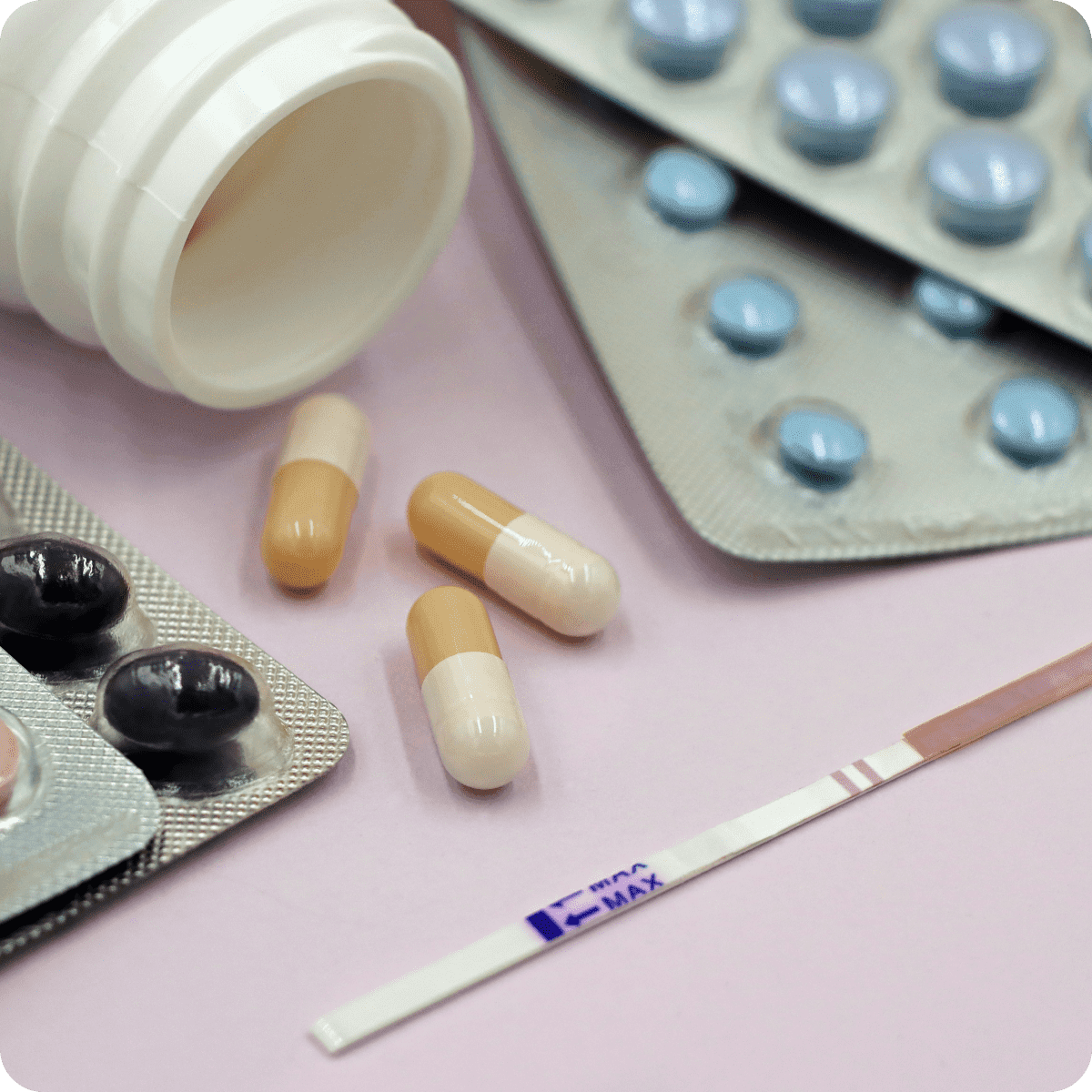Fertility naturally decreases as you age, starting from your mid-30s and drops more significantly as you approach menopause. The likelihood of pregnancy depends on how many eggs you have left and how often you are having sex. However, pregnancy can still occur during perimenopause, and when you’re on hormone replacement therapy (HRT). Therefore, contraception is necessary if you want to prevent a pregnancy.
The type of contraception you use is a joint decision between you and your doctor. It’s important to weigh up the pros and cons and risks and benefits of each choice as well as your personal preferences.
Does contraception affect menopause?
Using birth control will not impact when you enter perimenopause or reach menopause and will not alter the duration of menopause either. However, as many types of contraception are hormone-based, they can mask menopause symptoms.
Irregularities in your period, which are one of the main symptoms of perimenopause, can be hard to detect when on contraception as some women do not have periods at all and others will have an artificial 'withdrawal' bleed rather than a menstrual period. This can make determining where you are in your menopause transition more difficult.
Which contraceptives should I use during menopause?
There’s no one best contraception for women in their 40s or 50s. Instead, deciding on which contraception to use is a personal choice, based on several factors including:
- How well it works at preventing pregnancy
- Whether it protects against sexually transmitted diseases (STDs)
- How it is used
- Side effects and risks
- Impact on your periods
- Medical history
While contraceptives are predominantly used to prevent pregnancy, they can also help manage menstrual symptoms such as period pain and heavy bleeding. In perimenopause, some contraceptives ease symptoms such as hot flushes, night sweats and mood changes as they regulate the hormones that are naturally lost during this transition.
There are three types of birth control:
- Non-hormonal contraception
- Progesterone-only contraception
- Combined hormonal contraception
Non-hormonal and progesterone-only contraceptives can be used in conjunction with HRT but combined hormonal contraception cannot. This is because combined contraceptives include oestrogen.
Barrier methods
Barrier methods (like male or female condoms, diaphragms and caps) are generally very effective (if used properly) and work by physically blocking sperm from reaching an egg. If they fail, usually it’s because of a problem while using them, like a condom splitting.
Some women prefer using barrier contraception in midlife as they don’t affect your hormones, and so won’t mask the symptoms of perimenopause. Condoms are also the only form of birth control that can protect against the risk of some STDs.
Regardless of your age, the risks of using barrier methods are the same and include allergic reactions, urinary tract infections (UTIs), vaginal irritation and in very rare circumstances, toxic shock syndrome.
Copper coil (IUD)
The copper coil is a small, plastic T-shaped intrauterine device that is over 99% effective at preventing pregnancy. The coil is placed into the womb through the cervix (which sits at the top of the vagina). It does not use hormones but instead slowly releases copper into the uterus to prevent pregnancy.
It works as soon as it is put in and can last 5 or 10 years, depending on the type used. If the coil is put in after the age of 40, it can stay in until menopause and its use in perimenopause is supported by the Faculty of Sexual and Reproductive Healthcare (FSRH).
While using the copper coil won't result in any hormone side effects, it can make your periods heavier and longer, so may not be the best choice for women who already have these issues.
Hormonal coil (LNG-IUD)
A hormonal coil (also known as LNG-IUD) is a small, plastic T-shaped device inserted into the womb which releases the hormone progestogen over 3 to 8 years, depending on the type. The most common brand of IUS is the Mirena coil, but other brands include Levosert, Benilexa, Kyleena and Jaydess.
An IUS is over 99% effective at preventing pregnancy and can be an effective treatment for heavy periods. The Mirena, Levosert and Benilexa can also be used as the progesterone part of HRT as they release progesterone, but in this case would need to be changed every 5 years to keep the lining of the womb thin. The Kyleena and Jaydess are not licensed for HRT as they have a lower dose of progesterone.
The Mirena coil can remain in the womb until menopause if inserted at or after the age of 45, if purely used for contraception and not HRT.
Progesterone-only pill
There are several progesterone-only contraceptives. The 'mini pill' contains a low-dose progestogen and is over 99% effective if taken correctly all the time. It works by thickening the cervical mucus preventing the sperm reaching the egg. Some types can also stop ovulation (the ovaries from releasing an egg each month).
You take one tablet ideally at the same time each day, every day. Once you finish a 28-pill pack, you start a new pack the next day without any break.
Often, it leads to lighter periods or no periods, but some women experience some spotting between periods. Side effects are usually minimal, but some women report headaches, nausea, acne, mood swings or weight changes.
You cannot use this method of contraception as part of your HRT regimen as its low dose of progesterone does not provide enough protection against the oestrogen aspect of HRT. However, if you’re using the progesterone-only pill, you can usually take HRT alongside it and it’s safe to take until the age of 55 (after which contraception is no longer needed).
Progesterone implant
The progestogen implant is a small plastic rod about 4cm long that is placed under the skin of the arm. It releases progesterone to prevent the ovaries from releasing an egg each month and is over 99% effective so long as it’s replaced every three years.
It can help with heavy, painful periods but can also make periods irregular. It is safe to continue using until you’re 55 but as with the mini pill, it cannot be used in place of HRT but can be used safely in conjunction with HRT.
Progesterone injection
There are currently two progesterone injections in common use in the UK: Depo Provera and Sayana Press. The progestogen injection lasts for 8-13 weeks, depending on which type you have and is more than 99% effective in preventing pregnancy if you get your injections on time.
As with other forms of progesterone-based contraception, it releases the hormone to prevent ovulation.
The progesterone injection can reduce periods and many women have no periods at all while using it and cannot be used as a form of HRT but can be used alongside it.
If you are 50 or over you should have a chat with your doctor about whether it’s still the best contraception for you because with increasing age, other health issues which come into play must be considered, particularly bone health which can be affected by this injection.
Combined contraceptive pill or patch
The combined contraceptive pill and patch are the only forms of contraceptive that contain both oestrogen and progestogen. They are over 99% effective when used correctly.
Combined contraception can help with acne, heavy or painful periods, pre-menstrual syndrome (PMS) and endometriosis. They can also alleviate some symptoms of menopause such as irregular heavy bleeding, night sweats, and hot flushes. One downside of this form of birth control is that it can reduce your libido.
They are not recommended for use if you are over the age of 50 (or if you are younger and have an increased risk of clots or heart disease or migraines with an aura) as they increase the risk of blood clots, heart disease and stroke.
Combined contraception cannot be used if you’re taking HRT. A GP may recommend you continue to use combined contraception until 50 and then switch to HRT but this will depend on your personal circumstances and symptoms.
Surgical options
There are also permanent surgical options. Men can have a vasectomy and women a sterilisation, which is where the fallopian tubes are blocked or sealed to stop eggs from reaching sperm.
A sterilisation won’t affect your hormones, stop your periods or trigger menopause. If after sterilisation, your menopause symptoms are affecting your day-to-day life, HRT is likely to be recommended to help manage them.
When should I stop using contraception?
There is very little scientific evidence to go by. The Faculty of Sexual and Reproductive Health (FSRH) has guidelines that healthcare professionals can refer to. This claims that between the ages of 40 and 50, you can stop using contraception if you have not had a period for two years. Over 50 years old, you can stop contraception after not having a period for one year. The term ‘period’ here means a natural period, not a withdrawal bleed while on hormone treatment. As some contraception stops periods then it can be difficult to know when periods naturally stop, so it is often recommended to continue contraception until the age of 55. Even if women are still having periods, pregnancy after the age of 55 is exceptionally uncommon.
In some situations, a follicle-stimulating hormone (FSH) blood level can be checked in women over 50 years old to assess the likelihood of pregnancy, particularly if on a progesterone only method that stops periods. However, an FSH level would not be helpful if you are taking certain hormonal treatments with oestrogen e.g. HRT and the combined pill.
Fully understanding your options can help empower you to make the best choice for your own health and well-being. If you’d like to discuss the different forms of contraception and receive evidence-based, personalised recommendations, book a consultation with a Menopause Care specialist.





